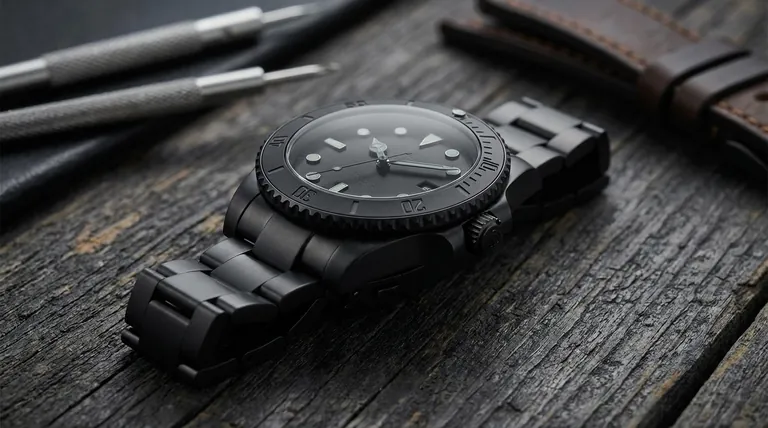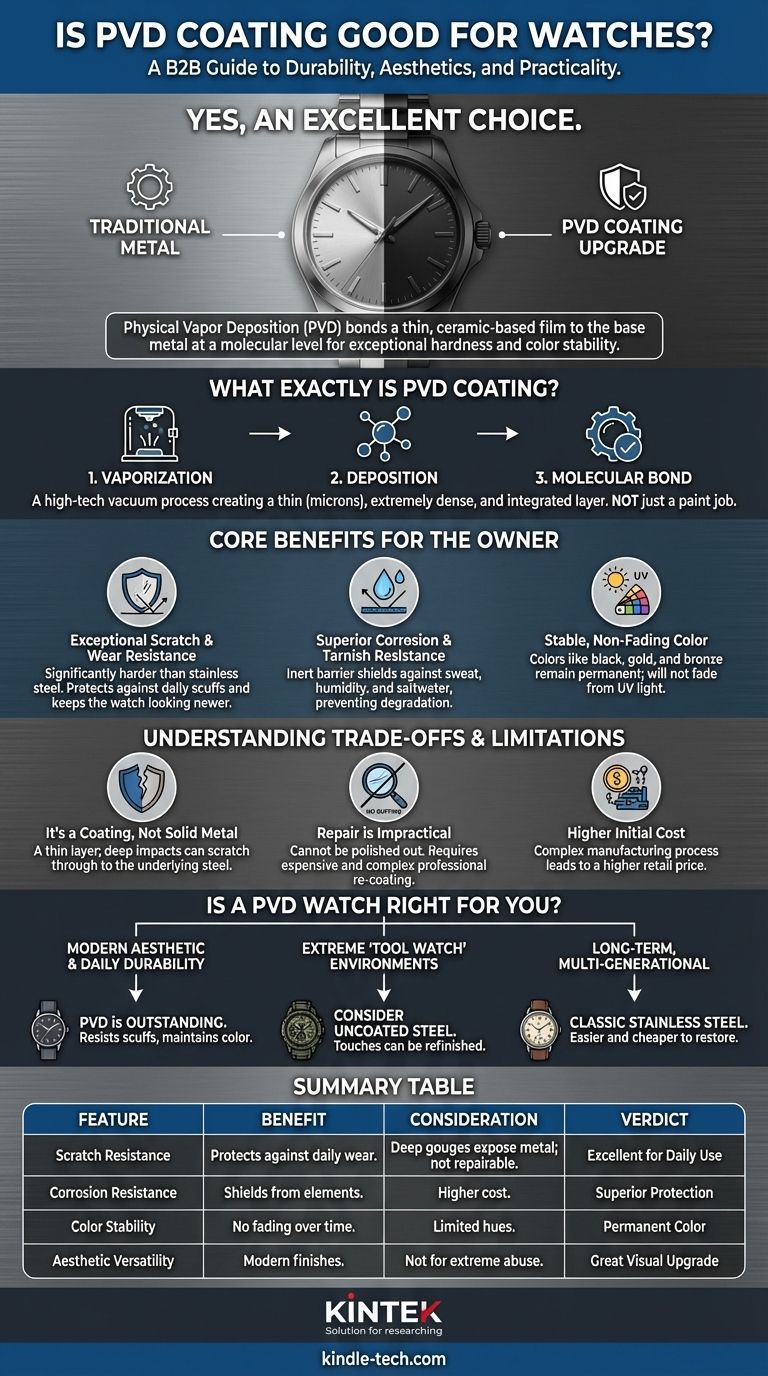Yes, PVD coating is an excellent choice for watches, offering a significant upgrade in durability and aesthetic versatility over traditional uncoated metals. Physical Vapor Deposition (PVD) bonds a thin, ceramic-based film to the watch's base metal at a molecular level, creating a finish that is exceptionally hard, corrosion-resistant, and available in a variety of stable colors like black, gold, and bronze.
The crucial takeaway is that PVD provides a tough, protective shell for your watch, not a solid material. While it dramatically increases resistance to daily wear and scratches, it is not invincible—a deep enough gouge can still expose the base metal underneath, and unlike uncoated steel, it cannot be easily polished or repaired.

What Exactly is PVD Coating?
PVD is a high-tech vacuum coating process. It is fundamentally different from older, less durable methods like electroplating or simple paint.
A Thin but Mighty Layer
The process involves vaporizing a solid material (like titanium nitride) in a vacuum chamber and depositing it onto the watch components as a pure, hard-wearing film. This layer is typically only a few microns thick, yet it is extremely dense and well-bonded.
More Than Just a "Paint Job"
Think of it like case-hardening a tool rather than painting a wall. The PVD coating becomes an integral part of the surface. This is why it doesn't chip or flake off the way a painted finish would.
Enhanced Protection and Aesthetics
This process is used to apply a topping that not only provides superior wear resistance but also achieves specific colors. The result is a finish that protects against corrosion from sweat and the environment while maintaining its color indefinitely.
The Core Benefits for a Watch Owner
For the end-user, the manufacturing complexity of PVD translates into tangible, real-world advantages.
Exceptional Scratch and Wear Resistance
PVD coatings are significantly harder than the stainless steel they typically cover. This provides a robust protective barrier against the minor scuffs, abrasions, and wear that accumulate during daily use, keeping the watch looking newer for longer.
Superior Corrosion and Tarnish Resistance
The coating creates an inert barrier that protects the underlying metal from sweat, humidity, and saltwater. This prevents any form of corrosion or tarnishing, ensuring the watch's integrity and appearance.
Stable, Non-Fading Color
Unlike older coating methods, PVD colors are incredibly stable. They will not fade or change color over time due to UV light exposure or chemical contact. A black PVD watch will remain black.
Understanding the Trade-offs and Limitations
To make an informed decision, you must also understand the technology's inherent limitations. Objectivity is key.
It's a Coating, Not Solid Metal
This is the most critical point to understand. While highly resistant, the coating is still just a thin layer. A sufficiently hard and sharp impact can scratch through the PVD to reveal the silvery stainless steel beneath.
Repair is Impractical
You cannot "buff out" a deep scratch on a PVD coating. Doing so would simply remove more of the coating around the scratch. The only true repair is to have the entire component professionally stripped and re-coated, which is often prohibitively expensive and complex.
Higher Initial Cost
The PVD process requires complex machinery, a vacuum environment, and skilled operators. This slow, high-tech process increases manufacturing costs, which is reflected in a higher retail price compared to an equivalent uncoated watch.
Is a PVD-Coated Watch Right for You?
Choosing a PVD finish depends entirely on your priorities and how you intend to use the watch.
- If your primary focus is a modern aesthetic with enhanced daily durability: PVD is an outstanding choice that will resist scuffs and maintain its color far better than bare steel.
- If your primary focus is a "tool watch" for extreme, hard-use environments: Be aware that while tough, significant impacts can breach the coating. A traditional brushed stainless steel finish may be more practical, as its deeper scratches can be refinished or simply add to the watch's character.
- If your primary focus is long-term, multi-generational ownership: A classic, uncoated stainless steel watch is far easier and cheaper to polish and restore to a like-new condition over decades of wear.
Ultimately, understanding that PVD offers superior surface protection—not invincibility—empowers you to choose a watch finish that perfectly aligns with your lifestyle and expectations.
Summary Table:
| Feature | Benefit | Consideration |
|---|---|---|
| Scratch Resistance | Protects against daily wear and minor abrasions | Deep gouges can expose the base metal; not easily repairable |
| Corrosion Resistance | Shields from sweat, humidity, and saltwater | Higher initial cost due to complex manufacturing process |
| Color Stability | Maintains color without fading over time | Limited to specific hues like black, gold, and bronze |
| Aesthetic Versatility | Offers modern finishes (e.g., black, gold, bronze) | Not suitable for extreme hard-use environments where deep scratches are likely |
Enhance Your Laboratory's Capabilities with KINTEK
At KINTEK, we specialize in high-performance lab equipment and consumables designed to meet the rigorous demands of modern laboratories. Whether you're researching advanced materials or developing precision instruments, our PVD coating solutions deliver unmatched durability and reliability. Contact us today to explore how our expertise can support your projects and elevate your results!
Visual Guide

Related Products
- RF PECVD System Radio Frequency Plasma-Enhanced Chemical Vapor Deposition RF PECVD
- Chemical Vapor Deposition CVD Equipment System Chamber Slide PECVD Tube Furnace with Liquid Gasifier PECVD Machine
- Microwave Plasma Chemical Vapor Deposition MPCVD Machine System Reactor for Lab and Diamond Growth
- Split Chamber CVD Tube Furnace with Vacuum Station Chemical Vapor Deposition System Equipment Machine
- VHP Sterilization Equipment Hydrogen Peroxide H2O2 Space Sterilizer
People Also Ask
- What are the applications of PECVD? Essential for Semiconductors, MEMS, and Solar Cells
- What is the principle of plasma enhanced chemical vapor deposition? Achieve Low-Temperature Thin Film Deposition
- What is plasma activated chemical vapour deposition method? A Low-Temperature Solution for Advanced Coatings
- What is an example of PECVD? RF-PECVD for High-Quality Thin Film Deposition
- How are PECVD and CVD different? A Guide to Choosing the Right Thin-Film Deposition Process



















